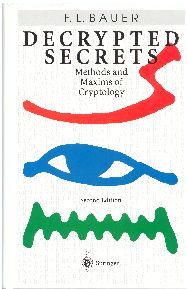
Decrypted Secrets: Methods and Maxims of Cryptology
F. L. Bauer
Springer, 2000, 470 pages

|
 his is one of the better books on cryptology
on the market, partly because of its emphasis on cryptanalytical
techniques, and partly because of its authoritativeness and technical
depth. The first half of the book introduces the reader into the
mathematical terminology and concepts while describing cryptological
systems used throughout history. In addition to in-depth information
on the struggles of early cryptographers to develop secure communications,
the book reveals historical facts overlooked by other authors such
as the codes used by Thomas Jefferson and the little-known role of
ciphers in the Dreyfus affair. Bauer's book also has detailed
information on the coding devices and schemes they used that reveals
a thorough understanding of their strengths and weaknesses.
The chapter on polyalphabetic substitution gives a far more detailed
and technical description of Enigma than most other books, showing
the actual substitutions for the stator and all 8 rotors.
his is one of the better books on cryptology
on the market, partly because of its emphasis on cryptanalytical
techniques, and partly because of its authoritativeness and technical
depth. The first half of the book introduces the reader into the
mathematical terminology and concepts while describing cryptological
systems used throughout history. In addition to in-depth information
on the struggles of early cryptographers to develop secure communications,
the book reveals historical facts overlooked by other authors such
as the codes used by Thomas Jefferson and the little-known role of
ciphers in the Dreyfus affair. Bauer's book also has detailed
information on the coding devices and schemes they used that reveals
a thorough understanding of their strengths and weaknesses.
The chapter on polyalphabetic substitution gives a far more detailed
and technical description of Enigma than most other books, showing
the actual substitutions for the stator and all 8 rotors.
It is also one of the few books that accurately describes the dreadful state of American ciphers in WWII. Despite the fact that many of our ciphers were broken long before the war even started, the Enigma-like American M-134-C (SIGABA) 15-rotor system was one of the few of any country's to remain intact throughout the war.
Although the mathematics in this book may look intimidating, much of it is merely a formalized way of restating in the language of number theory and linear algebra what is written in the text. The book also has several color photographs of WWII-era coding machines, including one of a page from a Russian one-time pad.
The most unique part of the book is the section on cryptanalysis. It is impossible to create a decent encryption system without a solid grasp of this subject, which rapidly becomes highly technical, but professionals reading this book will likely complain that too much time is spent on fairly rudimentary techniques like frequency analysis and not enough on more sophisticated techniques like differential cryptanalysis. The DES, for example, is well-known to be resistant to differential cryptanalysis, suggesting that the NSA understood this method well before its public disclosure in 1993.
By comparison, the no-frills book Manual of Cryptography by Gen. Luigi Sacco, which is part of the Cryptographic Series of books by luminaries in the field (including several by the great Friedman himself), also covers cryptanalytical techniques, but in a much less rigorous fashion than Decrypted Secrets. In earlier times, ciphers often relied on transposition methods, and Sacco's book, unlike more modern books, also covers this genre. Applied Cryptography by Bruce Schneier gives a much better description of differential cryptanalysis, DES and public key algorithms like RSA and elliptic curve systems, and concentrates exclusively on modern methods and concepts (such as the distinction, glossed over in Bauer, between stream and block ciphers), without delving into the mathematics. However, the best book on cryptanalysis, especially as it applies to DES, is still Wayne Patterson's 1987 excellent Mathematical Cryptology for Computer Scientists and Mathematicians which, although it wastes 70 pages on Pascal source code listings, has appendices on number theory and Galois fields that alone make the book worthwhile.
Each one of these books complements each other and would appeal to different readers. Decrypted Secrets is easily the best book for those interested in the technical history of WWII-style ciphers and nuts and bolts techniques for analyzing them.
